Auriga’s hexagon is a bright, prominent asterism formed by the brightest stars of Auriga – Capella, Menkalinan, Mahasim, Hassaleh, and Almaaz – with Elnath, the star that marks the northern horn of the Bull. The asterism lies in the northern sky, partly within the larger Winter Hexagon (Winter Circle). It is one of the most familiar features of the night sky on winter evenings.
Auriga’s hexagon can be used to find many deep sky objects located in the same area of the sky. These include the Messier open clusters M36, M37, and M38, the Flaming Star Nebula, and the Tadpole Nebula.
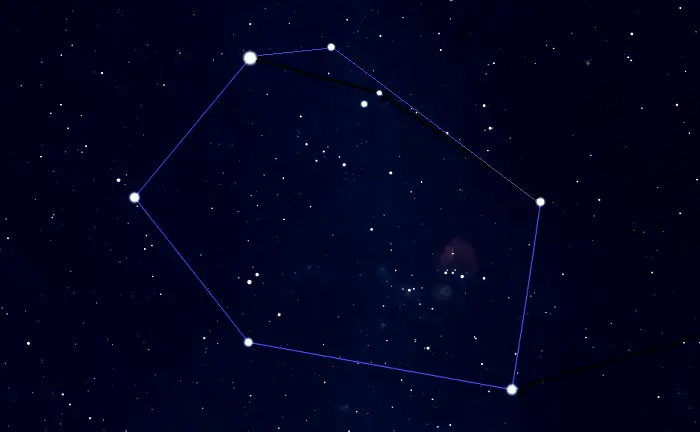
Auriga’s hexagon, image: Stellarium
Location
Auriga’s hexagon lies in the northern celestial hemisphere. Most of it appears within the Winter Hexagon, a much larger and brighter asterism formed by six first-magnitude stars. Capella is the northernmost star in the Winter Hexagon asterism. Other vertices are marked by Pollux in Gemini, Procyon in Canis Minor, Sirius in Canis Major, Rigel in Orion, and Aldebaran in Taurus.
Auriga’s hexagon is visible from most locations for at least part of the year. Auriga is almost circumpolar in the northern hemisphere. It can be seen almost year-round at some point in the night. However, the constellation is not as prominent for observers in the southern hemisphere because it does not rise very high above the horizon.
Capella, the northernmost star in the asterism, lies at a declination of 45° 60’. It is visible from most inhabited places on Earth, but it does not appear very high in the sky for southern observers. The star does not rise at all for observers south of the latitude 44° S. The entire constellation is visible from locations north of the latitude 40° S.
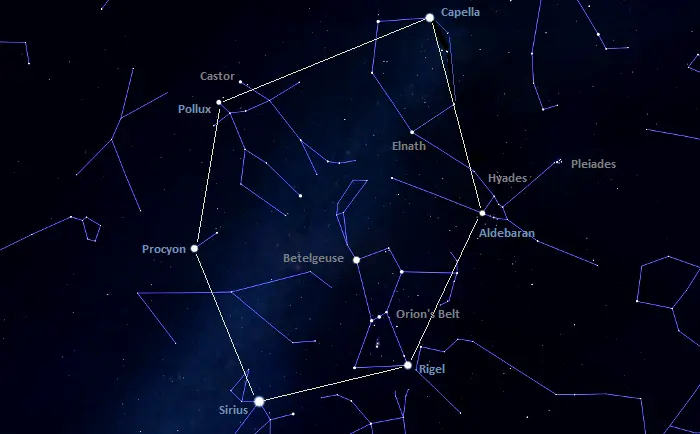
Auriga’s hexagon and the Winter Circle, image: Stellarium
Constellations
Auriga’s hexagon is formed by the stars of the constellations Auriga and Taurus. Both constellations are quite prominent in the sky. Auriga’s stars stand out in the northern sky, while Taurus hosts Aldebaran, the 14th brightest star in the sky, and two exceptionally bright and large open clusters, the Pleiades and the Hyades.
Auriga’s hexagon can be used to identify several constellations that appear in the same area of the sky. Perseus lies between Auriga and Cassiopeia. The constellation’s identifying feature, the Segment of Perseus, is a curving line of stars found between Capella and Cassiopeia’s W.
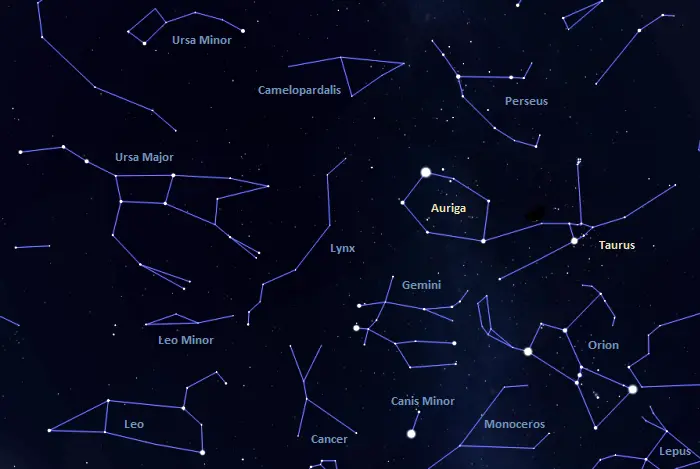
Constellations near Auriga’s hexagon, image: Stellarium
The constellation Gemini (the Twins) appears southeast of Auriga. Its brightest stars, Pollux and Castor, are among the brightest stars in the sky.
The faint Camelopardalis (the Giraffe) appears north of Auriga, while Lynx appears to the east and northeast, between Auriga’s hexagon and Ursa Major.
Stars
Auriga’s hexagon is formed by the bright stars Capella (Alpha Aurigae), Elnath (Beta Tauri), Menkalinan (Beta Aurigae), Mahasim (Theta Aurigae), Hassaleh (Iota Aurigae), and Almaaz (Epsilon Aurigae). With the exception of Elnath, the second brightest star in Taurus, these stars lie in the constellation Auriga. They outline the constellation figure of the celestial Charioteer.
The stars of Auriga’s hexagon are easily visible even in light-polluted skies. Capella, the brightest star in the asterism, is the sixth brightest star in the sky. Elnath and Menkalinan are the 27th and 41st brightest stars respectively. Mahasim, Hassaleh, and Almaaz are fainter but easily visible to the unaided eye in relatively good conditions.
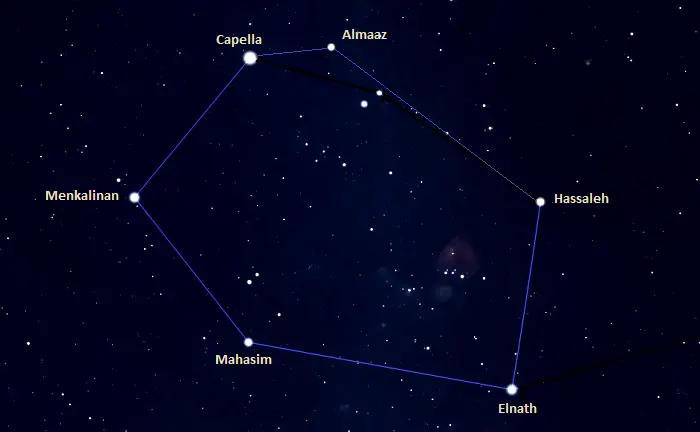
The stars of Auriga’s hexagon, image credit: Stellarium
Capella
Capella (Alpha Aurigae) is the brightest star in Auriga and the sixth brightest star in the sky. It shines at magnitude 0.08 from a distance of 42.9 light-years. It is the third brightest star in the northern celestial hemisphere, after Arcturus in the constellation Boötes and Vega in Lyra.
Capella is the primary component in a quadruple-star system composed of two binary pairs. The brighter pair, Alpha Aurigae Aa (Capella) and Alpha Aurigae Ab, are giant stars, while the fainter pair, Capella H and Capella L, are red dwarfs.
The main pair, commonly referred to as Capella A, has an average combined apparent magnitude of 0.08. Capella H shines at magnitude 10.16 and Capella L, 13.7. The red dwarfs are not visible to the unaided eye.
Capella (α Aur Aa) is a red clump giant of the spectral type K0III. It has a mass 2.57 times that of the Sun and a radius of 11.98 solar radii. The star is 78.7 times more luminous than the Sun with an effective temperature of 4,970 K. With a projected rotational velocity of about 4.1 km/s, the star completes a rotation in 104 days.
The close companion, Alpha Aurigae Ab, is an evolutionary subgiant with the stellar classification G1III, indicating a yellow giant. The star has a mass of 2.48 solar masses and a radius 8.85 times that of the Sun. With a surface temperature of 5,730 K, it shines with 9.83 solar luminosities. It spins at 35km/s, taking about 8.5 days to complete a rotation.
The two components orbit each other with a period of 104.02128 days. They are separated by only 0.056442 arcseconds, corresponding to a physical separation of 0.74272 astronomical units (74% of the Earth’s distance from the Sun). The system has an estimated age between 590 and 650 million years.
Capella H is a red dwarf of the spectral type M2.5 V. It has a mass of 0.57 solar masses and a radius of 0.54 solar radii. Capella L has the stellar classification M4 and a mass 54% that of the Sun.
Capella H and Capella L have an orbital period of 300 years. They orbit each other at a separation of 3.5 arcseconds, or 40 astronomical units.
The name Capella is the Latin word for “little goat.” In Greek mythology, the star is associated with the goat Amalthea, the foster mother of the god Zeus.
Elnath
Elnath (Beta Tauri) is the second-brightest star in Taurus and the 27th-brightest star in the sky. It marks the Bull’s northern horn. The star once belonged to both Taurus and Auriga and had the Bayer designation Gamma Aurigae.
Elnath shines at magnitude 1.65 from a distance of 134 light-years. It is a luminous blue giant of the spectral type B7III. The star has a mass 5 times that of the Sun and a radius 4.2 times solar. With an effective temperature of 13,824 K, it is 700 times more luminous than the Sun. The star’s estimated age is about 100 million years.
The name Elnath refers to the Bull’s horns. It comes from the Arabic an-naţħ, meaning “the butting.”
Menkalinan
Menkalinan (Beta Aurigae) is the second-brightest star in Auriga and the 41st-brightest star in the sky. It is an Algol-type eclipsing binary star. The two components, Beta Aurigae Aa and Beta Aurigae Ab, block each other’s light as they orbit, which results in the system’s brightness varying between magnitude 1.89 and 1.98. The stars orbit each other with a period of 3.96 days. The orbital period corresponds to the period of brightness variations. The estimated age of Menkalinan is 570 million years.
Both stars have the stellar classification A1m IV, indicating white subgiants. They have roughly the same radius and mass. The primary component has a mass of 2.389 solar masses and a radius of 2.77 solar radii, while the secondary has a mass of 2.327 solar masses and a radius 2.63 times that of the Sun. The primary star is slightly more luminous. It shines with 55 solar luminosities, while the companion has an energy output of 47 Suns.
The name Menkalinan comes from the Arabic phrase mankib ðī-l-‘inān, meaning “shoulder of the rein-holder.”
Mahasim
Mahasim (Theta Aurigae) is the third-brightest star in Auriga. It shines at magnitude 2.65 on average and lies 166 light-years away.
Theta Aurigae is a binary star system composed of a chemically peculiar A-type star and an F-type dwarf. The primary component (formally known as Mahasim) has a mass 3.24 times that of the Sun and a radius 4.68 times solar. It is 214 times more luminous than the Sun with an effective temperature of 10,220 K. The star has an estimated age of 288 million years.
Mahasim is classified as an Alpha2 Canum Venaticorum variable. Its brightness varies from magnitude 2.62 to 2.70. Alpha2 Canum Venaticorum variables have strong magnetic fields and chemical peculiarities in their spectra. Their spectral lines and magnetic fields also vary. The periods of brightness variations in these stars correspond to their rotation periods. Mahasim spins at 55 km/s and completes a rotation in 3.6187 days.
The companion has an apparent magnitude of 7.2 and is separated by 3.91 arcseconds from the primary component.
The name Mahasim comes from the Arabic al-miʽşam, meaning “the wrist.” It refers to the wrist of the Charioteer (Auriga).
Hassaleh
Hassaleh (Iota Aurigae) is the fourth-brightest star in Auriga. It has an apparent magnitude of 2.7 and lies approximately 490 light-years away.
Iota Aurigae is an orange bright giant star of the spectral type K3 II. It has a mass 7.1 times that of the Sun and a radius 127 times the Sun’s. It is 4,581 times more luminous than the Sun with a surface temperature of 4,160 K. The estimated age of Hassaleh is about 39.8 million years.
The origin of the name Hassaleh is uncertain. The name appeared in Czech astronomer Antonín Bečvář’s star atlas Atlas Coeli Skalnate Pleso (1951). The star was traditionally also known as Kabdhilinan, from the Arabic word for “the ankle,” and Alkab.
Almaaz
Almaaz (Epsilon Aurigae) is the fifth-brightest star in Auriga. Like Menkalinan, it is classified as an Algol variable, an eclipsing binary system whose components periodically obscure each other’s light. Its brightness varies from magnitude 2.92 to 3.83. The system lies approximately 3,300 light years away.
The nature of the Epsilon Aurigae system is a puzzle to astronomers. The primary component is believed to be a supergiant star of the spectral type F0 Iab, but it may be a giant or bright giant star. Its brightness drops to magnitude 3.83 every 27.1 years and the eclipse lasts for 640 – 730 days.
The secondary component is a huge dark disk that orbits an object whose nature is unknown. The object is believed to be a binary system composed of two small, hot B-type stars.
The name Almaaz comes from the Arabic Al Maʽaz, meaning “the billy goat.” It corresponds to the name of the brighter Capella, which is Latin for “little goat” or “nanny goat.”
Almaaz is sometimes included in a smaller asterism known as the Haedi (the Kids). Formed by Haedus (Eta Aurigae) and Saclateni (Zeta Aurigae), the asterism represents the kids of Amalthea (the goat associated with Capella). Almaaz was historically not part of the asterism, but some observers include it because it forms an elongated triangle with Haedus and Saclateni.
Deep sky objects
Auriga’s hexagon can be used to find a number of bright deep sky objects. The region between Mahasim and Hassaleh is popular among astrophotographers because it hosts several relatively bright nebulae and star clusters.
The open cluster Messier 38, popularly known as the Starfish Cluster, appears roughly halfway between the two stars. With an apparent magnitude of 7.4 and an apparent size of 21 arcminutes, it is an easy target for small telescopes. The cluster lies 3,480 light-years away.
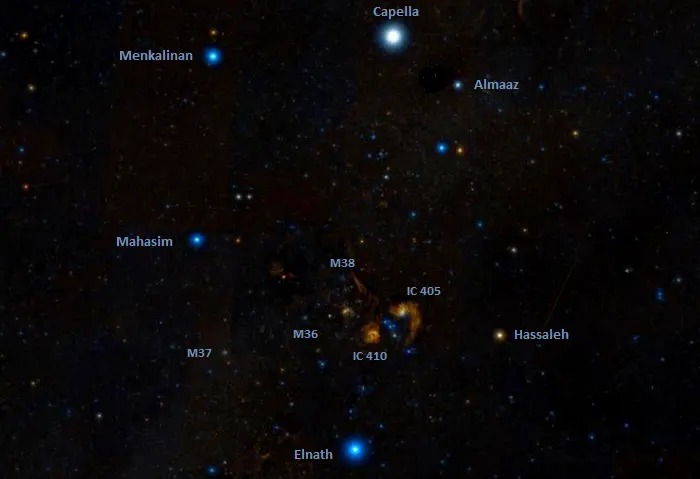
Deep sky objects near Auriga’s hexagon, image: Wikisky
The Flaming Star Nebula (IC 405) appears southwest of M38. It is an emission and reflection nebula located approximately 1,500 light-years away. The nebula is illuminated by the young variable star AE Aurigae.
The Tadpole Nebula (IC 410), an emission nebula associated with the open star cluster NGC 1893, appears southeast of the Flaming Star Nebula, near the imaginary line connecting Capella and Elnath.
The smaller, fainter nebulae IC 417 and NGC 1931, popularly known as the Spider and the Fly, appear in the same area.
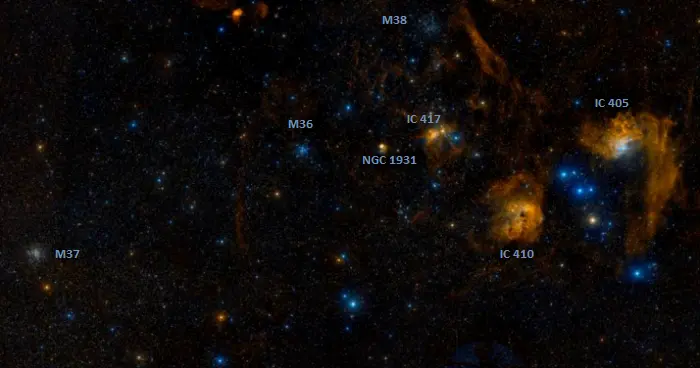
Deep sky objects in Auriga, image: Wikisky
The bright open clusters Messier 36 and Messier 37 can be found using Mahasim and Elnath. The lie on either side of the midpoint of the imaginary line connecting the two stars.
The famous Crab Nebula (Messier 1), a supernova remnant in the constellation Taurus, is found near Tianguan (Zeta Tauri), the star marking the Bull’s southern horn, in the direction of Elnath, the northern horn.
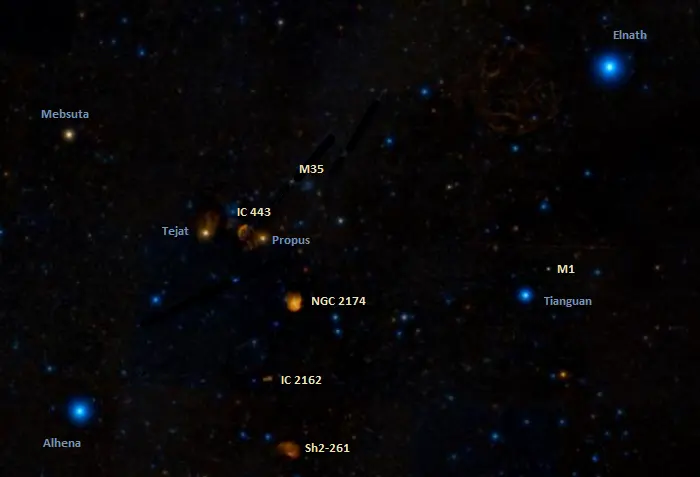
Elnath, Alhena, Messier 35, Jellyfish Nebula and Monkey Head Nebula, image: Wikisky
The region between Elnath in Taurus and Alhena in Gemini hosts several bright deep sky objects: Messier 35, the Jellyfish Nebula (IC 443), and the Monkey Head Nebula (NGC 2174).
The open cluster Messier 35 has an apparent magnitude of 5.3 and an angular size of 28 arcminutes. It lies 2,970 light-years away and appears 2 degrees northwest of Propus (Eta Geminorum) at the foot of Castor. The cluster is one of the most popular targets for small telescopes.
The Jellyfish Nebula (IC 443, Sh2-248) is a supernova remnant located about 5,000 light years away in Gemini. It has an angular diameter of 50 arcminutes, corresponding to a physical size of about 70 light years. The Jellyfish appears next to Propus in the sky.
The Monkey Head Nebula (NGC 2174) is an emission nebula about 6,400 light-years away in the constellation Orion. It appears near the imaginary line connecting Alhena and Elnath.